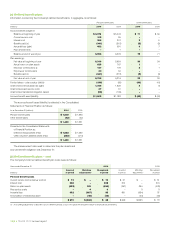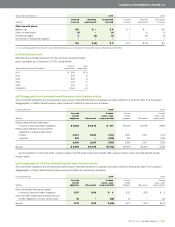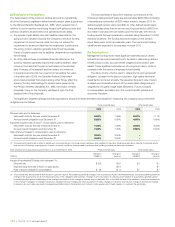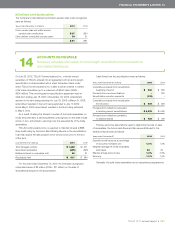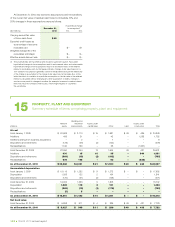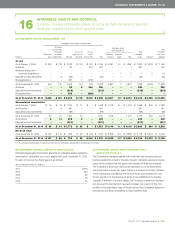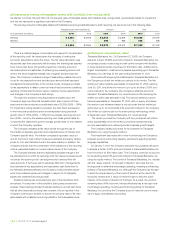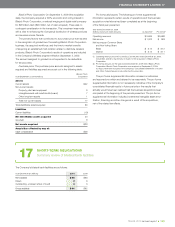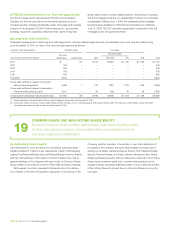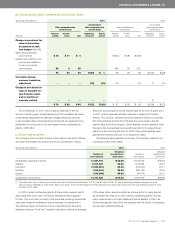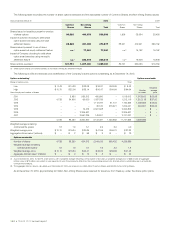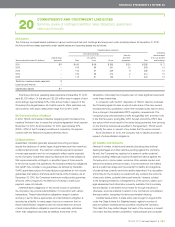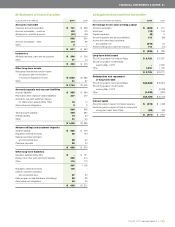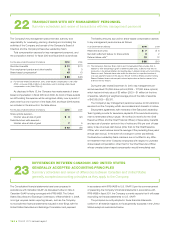Telus 2010 Annual Report Download - page 158
Download and view the complete annual report
Please find page 158 of the 2010 Telus annual report below. You can navigate through the pages in the report by either clicking on the pages listed below, or by using the keyword search tool below to find specific information within the annual report.
154 . TELUS 2010 annual report
(d) Impairment testing of intangible assets with indefinite lives and goodwill
As referred to in Note 1(b) and Note 1(f), the carrying value of intangible assets with indefinite lives, and goodwill, is periodically tested for impairment
and this test represents a significant estimate for the Company.
The carrying amounts of intangible assets with indefinite lives and good
will allocated to each reporting unit are as set out in the following table.
Intangible assets with indefinite lives Goodwill To ta l
As at December 31 (millions) 2010 2009 2010 2009 2010 2009
Wireless $ß3,856 $ß3,856 $ß2,606 $ß2,606 $ß6,462 $ß6,462
Wireline – – 966 966 966 966
$ß3,856 $ß3,856 $ß3,572 $ß3,572 $ß7,428 $ß7,428
There is a material degree of uncertainty with respect to the estimates
of the reporting units’ fair values given the necessity of making key
economic assumptions about the future. The fair value calculation uses
discounted cash flow projections which employ the following key assump-
tions: future cash flows and growth projections, including economic
risk assumptions and estimates of achieving key operating metrics and
drivers; the future weighted average cost of capital; and earnings mul-
tiples. The Company considers a range of reasonably possible amounts
to use for key assumptions and decides upon amounts that represent
management’s best estimate. In the normal course, changes are made
to key assumptions to reflect current (at time of test) economic conditions,
updating of historical information used to develop the key assumptions
and changes in the Company’s debt ratings.
The cash flow projection key assumptions are based upon the
Company’s approved financial forecasts which span a period of three
years and are discounted at a consolidated rate of 8.25% (2009 – 7.61%).
For impairment testing valuation purposes, the cash flows subsequent
to the three-year projection period are extrapolated using perpetual
growth rates of 1.75% (2009 – 1.75%) for the wireless reporting unit and
zero (2009 – zero) for the wireline reporting unit; these growth rates do
not exceed the observed long-term average growth rates for the markets
in which the Company operates.
The Company validates its fair value results through the use of
the market-comparable approach and analytical review of industry and
Company-specific facts. The market-comparable approach uses cur-
rent (at the time of test) market consensus estimates and equity trading
prices for U.S. and Canadian firms in the same industry. In addition, the
Company ensures that the combination of the valuations of the reporting
units is reasonable based on current market values of the Company.
The Company believes that any reasonably possible change in the
key assumptions on which its reporting units’ fair values are based would
not cause the reporting units’ carrying amounts to exceed their fair
value amounts. If the future was to adversely differ from management’s
best estimate of key assumptions and associated cash flows were to
be materially adversely affected, the Company could potentially experi-
ence future material impairment charges in respect of its intangible
assets with indefinite lives and goodwill.
Sensitivity testing was conducted as a part of the December 2010
annual test. A component of the sensitivity testing was a break-even
analysis. Stress testing included moderate declines in annual cash flows
with all other assumptions being held constant; this too resulted in the
Company continuing to be able to recover the carrying value of its intan-
gible assets with indefinite lives and goodwill for the foreseeable future.
(e) Business acquisitions; other
Transactel Barbados, Inc.: On December 22, 2008, the Company
acquired a direct 29.99% economic interest in Transactel Barbados, Inc.,
a business process outsourcing and call centre company with facilities
in three Central American countries, for $19 million cash. Additional con-
tingent consideration could become payable depending upon Transactel
Barbados, Inc. earnings for the year ending December 31, 2011.
Concurrent with acquiring the initial interest in Transactel Barbados, Inc.,
the Company provided two written put options to the vendor. The first
written put option became exercisable on December 31, 2009, expiring
June 30, 2011, and allows the vendor to put up to a further
21.01% eco-
nomic interest to the Company (the Company’s effective
economic
interest in Transactel Barbados, Inc. would become 51% assuming the
written put option was exercised in full). The second written put option
became exercisable on December 31, 2010, with no expiry, and allows
the vendor to put whatever interest is not put under the first written put
option plus up to an incremental 44% economic interest to the Company.
The written put options set out the share pricing methodology, which
is dependent upon Transactel Barbados, Inc. future earnings.
The vendor provided the Company with two purchased call options
which substantially mirror the written put options except that they
are only exercisable upon achieving certain business growth targets.
The Company initially accounted for its investment in Transactel
Barbados, Inc. using the equity method.
The investment was made with a view to enhancing the Company’s
business process outsourcing capacity, particularly regarding Spanish-
language capabilities.
On January 7, 2011, the Company exercised its purchased call option
to acquire a further 21.01% economic interest in Transactel Barbados, Inc.
from the vendor for $20 million cash. The Company continues to account
for its resulting direct 51% economic interest in Transactel Barbados, Inc.
using the equity method. The control of Transactel Barbados, Inc. resides
with the “super-majority” of its board of directors, who have the con-
tinuing power to determine the strategic operating, investing and financing
policies of Transactel Barbados, Inc. Although the Company has the right
to elect the simple majority of the board of directors at the direct 51%
economic interest level, it does not have the right to elect the super-
majority of the board of directors at that level. As a result, the vendor’s
remaining direct 49% economic interest effectively has a veto right over
the strategic operating, investing and financing policies of Transactel
Barbados, Inc. and thus the Company does not have the control neces-
sary to apply consolidation accounting.




